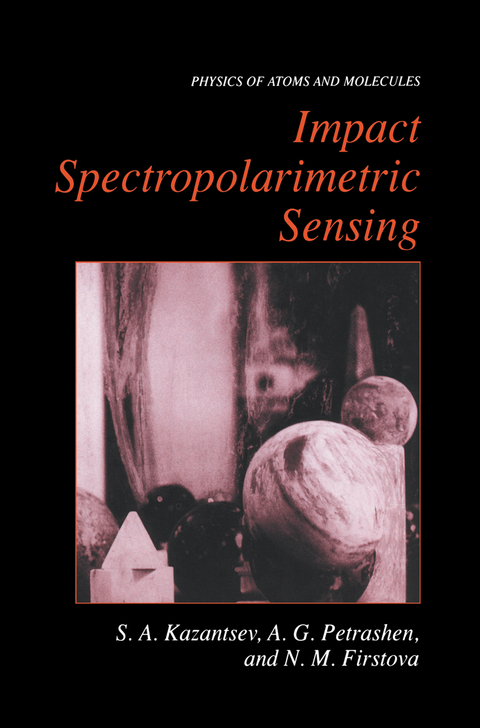
Impact Spectropolarimetric Sensing
Kluwer Academic/Plenum Publishers (Verlag)
978-0-306-45892-7 (ISBN)
1. Physical Introduction: Concepts, Phenomenology, Retrospectives, Applications.- 1.1. Polarization of Atomic Ensembles in Ionized Media.- 1.2. Polarization of Solar Flare Emission.- 1.3. Impact Polarization.- 1.4. Gas Discharge Studies.- 1.5. Collisional Kinetics of Polarization.- 1.6. Spectropolarimetric Sensing.- 1.7. Polarization Effects in the Earth Atmosphere.- 2. Polarization of a Photon Beam.- 2.1. Introduction.- 2.2. Wave Function of a Photon.- 2.3. Momentum, Spin, and Parity of a Photon.- 2.4. Rotation Matrix.- 2.5. Spinors.- 2.6. Relationship between the Polarization Direction and Characteristics of a Photon.- 2.7. Relationship between Stokes Parameters and the Characteristics of an Optical Field.- 2.8. Concluding Remarks.- 3. Theory of Collisional Spectropolarimetric Effects.- 3.1. Introduction.- 3.2. Density Matrix of an Atomic Ensemble.- 3.3. Polarization Density Matrix.- 3.4. Polarization Moments of the Density Matrix.- 3.5. Physical Meaning of Polarization Moments.- 3.6. Polarization Moments and Spectral Characteristics of an Atomic Ensemble.- 3.7. Density Matrix Relaxation Theory.- 3.8. Collisional Evolution of Polarization Moments.- 3.9. Interaction with an Electromagnetic Field.- 3.10. Impact Alignment Cross Section.- 3.11. Anisotropic Collisional Relaxation of Excited Hydrogen Atoms.- 3.12. Spectropolarimetric Effects for Angular Correlation Experiments.- 3.13. Concluding Remarks.- 4. Fast Particle Collision with a Heavy Atomic Target.- 4.1. Introduction.- 4.2. Born Expansion of the Scattering Amplitude.- 4.3. The Glauber Approximation.- 4.4. The System of Impact Parameter Equations.- 4.5. Concluding Remarks.- 5. Theory of Anisotropic Collisional Relaxation.- 5.1. Introduction.- 5.2. Symmetry of the Collisional Relaxation Cross Section Matrix.- 5.3.Rate Constants of Collisional Relaxation in Case of Partial Anisotropy.- 5.4. Distribution Functions of Relative Velocities.- 5.5. Collisional Relaxation of Polarization Moments under Intermultiplet Mixing.- 5.6. Anisotropie Collisional Alignment of a Narrow Multiplet.- 5.7. Anisotropie Relaxation and Polarization of Light.- 5.8. Depolarizing Collisions with Charged Particles.- 5.9. Concluding Remarks.- 6. Theory of Charge Exchange Polarization.- 6.1. Introduction.- 6.2. Theory of an Electron in the Field of Two Coulomb Centers.- 6.3. Distorted Wave Approximation Theory.- 6.4. Pseudolevel Technique for Computing the Polarization of Ions.- 6.5. Concluding Remarks.- 7. Spectropolarimeters for Solar Problems.- 7.1. Introduction.- 7.2. Spectropolarimetric Techniques of Meudon Observatory (France).- 7.3. Polarimetric Observations in the Crimean Astrophysical Observatory (Ukraine).- 7.4. The Spectropolarimeter of the Institute of Solar and Terrestrial Physics (Irkutsk, Russia).- 7.5. Solar Spectropolarimeter of Sacramento Peak Observatory (USA).- 7.6. Concluding Remarks.- 8. Solar Flare Observations at the Crimean Astrophysical Observatory (Ukraine).- 8.1. Introduction.- 8.2. Technique of Observation and Data Processing.- 8.3. Degree of Polarization along the Hydrogen H? Line.- 8.4. Spatial Distribution of the Degree of Polarization.- 8.5. Orientation of the Polarization Plane.- 8.6. Concluding Remarks.- 9. Observations of Polarization Effects at the Irkutsk Institute of Solar and Terrestrial Physics (Russia).- 9.1. Introduction.- 9.2. Spectropolarimetric Parameters of H? and H? Lines for the Flare on 15.09.1981.- 9.3. Spectropolarimetric Parameters of the Active Region 5669 (SGD) on 07.09.1989.- 9.4. Detection of the Linear Polarization of the Flare on 16.05.1991.- 9.5.Concluding Remarks.- 10. Solar Flare Observations at Meudon Observatory (France).- 10.1. Introduction.- 10.2. Linear Polarization of Emission of the Flare on 17.05.1980.- 10.3. Spectropolarimetric Effects of the Flare on 15.07.1980.- 10.4. Spectropolarimetric Features of Three Flares on 11.07.1982.- 10.5. Polarization Effects of the Emission of Two Flares on 17.07.1982.- 10.6. Concluding Remarks.- 11. Spectropolarimetric Measurements of Mustaches.- 11.1. Introduction.- 11.2. Polarization of Emission of Mustaches near the Solar Limb.- 11.3. Spectropolarimetric Measurements of Mustaches with an H? Filter.- 11.4. Improved Spectropolarimetric Observations of Mustaches on 14.11.1985.- 11.5. Observations of Mustaches at Baikal Astrophysical Observatory.- 11.6. Observations of Mustaches at Sacramento Peak Observatory.- 11.7. Concluding Remarks.- 12. Methodology of Impact Spectropolarimetric Sensing.- 12.1. Introduction.- 12.2. Spectropolarimetric Sensing Using Ground-Based Observations.- 12.3. Role of the Solar Magnetic Field.- 12.4. Linear Polarization of H? and H? Hydrogen Lines in the Born Approximation.- 12.5. Linear Polarization of the H? Hydrogen Line in the Glauber Approximation.- 12.6. Linear Polarization of H? and H? Hydrogen Lines by the Impact Parameter Method.- 12.7. Linear Polarization of the L? Hydrogen Line.- 12.8. Concluding Remarks.- 13. Impact Spectropolarimetric Diagnostics of Nonthermal Phenomena in the Solar Atmosphere.- 13.1. Introduction.- 13.2. Energy Transport into the Chromospheric Region of a Solar Flare.- 13.3. Determination of Proton Energy for the Flare on 16.05.1991.- 13.4. Impact Spectropolarimetric Sensing for the Flare on 15.09.1981.- 13.5. Impact Spectropolarimetric Sensing of Mustaches.- 13.6. Concluding Remarks.- 14. Conclusions.-References.
| Erscheint lt. Verlag | 31.8.1999 |
|---|---|
| Reihe/Serie | Physics of Atoms and Molecules |
| Zusatzinfo | XI, 361 p. |
| Verlagsort | New York |
| Sprache | englisch |
| Maße | 155 x 235 mm |
| Themenwelt | Naturwissenschaften ► Physik / Astronomie ► Astronomie / Astrophysik |
| Naturwissenschaften ► Physik / Astronomie ► Atom- / Kern- / Molekularphysik | |
| ISBN-10 | 0-306-45892-6 / 0306458926 |
| ISBN-13 | 978-0-306-45892-7 / 9780306458927 |
| Zustand | Neuware |
| Informationen gemäß Produktsicherheitsverordnung (GPSR) | |
| Haben Sie eine Frage zum Produkt? |
aus dem Bereich


